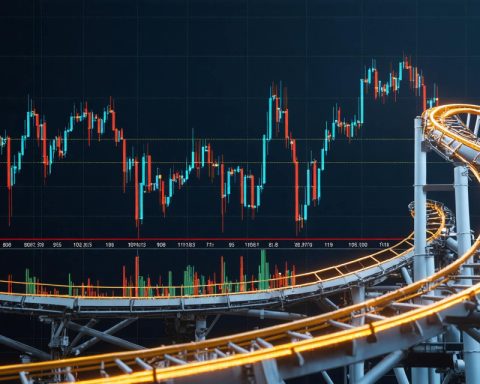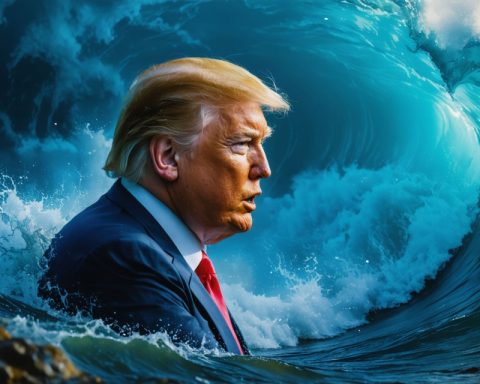- US tariffs of up to 54% on Chinese imports, and levies on other Asian economies, shake global trade dynamics.
- Asian stock markets experience steep declines: the Nikkei 225 drops 2.8%, and the Kospi falls 2.7%.
- Key industries hit hard; tech and automotive stocks like Sony, Toyota, and Samsung see significant value losses.
- Gold prices soar above $3,160 an ounce, becoming a refuge for investors amid financial instability.
- China vows countermeasures against US tariffs, escalating economic tensions.
- Japan and South Korea express concerns over the economic impact and initiate emergency strategies to address trade disruptions.
- Taiwan critiques tariffs’ rationale and prepares for potential trade consequences.
- The global economy faces challenges as protectionist policies test international trade relations.
A gust of economic turbulence swept through Asian stock markets as dawn broke on Thursday, with traders grappling to grasp the ramifications of sweeping US tariffs hastily unveiled by President Trump. In an unprecedented move to reshape global trade dynamics, the US president cast a wide net, imposing tariffs reaching 54% on Chinese imports and significant levies on other major Asian economies. This bold stroke has left the region reeling and wondering about the future of international commerce.
Across the bustling floors of Tokyo and Seoul, the lifeblood of tech and automotive industries felt the sting sharply. The venerable Nikkei 225 dropped precipitously, depicting a cascading wave of uncertainty with a close of 2.8% down. South Korea’s Kospi mirrored this trend, unable to stem a 2.7% plunge. Hong Kong’s Hang Seng Index and Australia’s ASX 200 weren’t spared either, sliding into losses as their financial community digested the potential upheavals.
The implications of these tariffs ripple far beyond stock tickers and fluctuating indices. Giant corporations like Sony saw share values melt away—over 5% vanished in morning trades—while automotive titans Toyota and Honda scrambled to assess the deep-cutting impact of new duties. Across the Sea of Japan, South Korean stalwarts like Samsung and Hyundai faced similar fates, watching helplessly as investor confidence eroded.
Amid this financial tempest, the allure of gold shone—literally—brighter than ever, reaching unprecedented heights above $3,160 an ounce. Gold, once again, became the bastion for anxious investors seeking shelter from the storm unleashed by rising tariffs.
As the sun rose over Washington D.C., the aftermath of Trump’s Rose Garden address expanded into a broader economic conflict, straining ties with allies and adversaries alike. Intended to boost American manufacturing, this trade offensive triggered countermeasures from China, which denounced the decision as unilateral aggression, pledging to defend its economic interests with equal vigor.
In diplomatic corridors from Beijing to Seoul, a chorus of voices resonated with dismay and determination. Japan’s cabinet, led by Chief Secretary Yoshimasa Hayashi, voiced deep concerns over the significant toll these tariffs could extract from their economic partnership with the United States. With billions at stake, especially in the automotive sector due to looming tariffs on all foreign vehicles, Japan finds itself on a precarious economic precipice.
South Korea, faced with its own economic trials, rallied under the temporary stewardship of acting President Han Duck-soo. An emergency cabinet meeting illustrated the severity with which Seoul perceives these tariffs, as industries brace for impacts expected to devastate key exports like steel and automobiles.
Taiwan, although spared some direct hits on its pivotal semiconductor exports, lambasted the tariffs’ flawed rationale. The island’s economic arteries flutter at the thought of enduring trade friction with its indispensable trade partner.
The developing scenario underscores an essential truth in today’s interconnected economy: unilateral moves ripple globally. As the world watches and Asian markets recalibrate their strategies, the overarching question remains—at what cost does protectionism come? For businesses and lawmakers, understanding this new trade landscape is now more vital than ever. The path forward lies in navigating multifaceted dialogues, seeking not just economic revival but harmony in global commerce.
The Ripple Effects of US Tariffs: What This Means for Global Trade and How You Can Prepare
Understanding the Impact of US Tariffs on Asian Markets
The recent imposition of US tariffs on Asian imports has sent shockwaves through global markets, with significant economic implications for both immediate and future international commerce. When President Trump announced tariffs as high as 54% on Chinese goods, markets reacted quickly, showcasing the interdependencies of modern trade.
Key Economic Repercussions
– Stock Market Volatility: Major Asian stock indices like Tokyo’s Nikkei 225 and South Korea’s Kospi saw dramatic drops of nearly 3%. This signifies broader concerns about economic stability and investor confidence.
– Corporate Impact: Major technology and automotive companies, such as Sony, Toyota, and Samsung, experienced significant declines in share value. This downturn highlights the potential long-term impact on production and international competitiveness.
– Rise of Safe-Haven Assets: As uncertainty looms, investors flock to gold, pushing its price to unprecedented levels above $3,160 an ounce.
How-To Steps & Life Hacks for Businesses
1. Diversification: Businesses should explore diversifying their supply chains to mitigate reliance on any single market.
2. Hedging Strategies: Consider financial hedging against currency and commodity fluctuations to protect against unpredictable market changes.
3. Trade Partnerships: Strengthen relationships with alternative trade partners to maintain a steady flow of goods and services.
Real-World Use Cases
– Tech Industry: Companies like Apple and Dell can evaluate shifting production to nations with lower tariff implications, reducing manufacturing costs.
– Automotive Sector: Firms may consider localizing production or assembly processes in the US to circumvent tariffs and tap into local markets.
Reviews & Comparisons
– Trade Policies: Compare US tariff strategies with those of the EU or other major economies. The EU often employs negotiation and trade agreements rather than aggressive tariffs.
Controversies & Limitations
– Economic Retaliation: While aimed at protecting domestic industries, tariffs can lead to retaliatory measures, escalating into a trade war, further disrupting global markets.
Insights & Predictions
– Short-Term vs. Long-Term Effects: While immediate economic impacts are evident, long-term consequences could include shifts in global trade power dynamics and new alliances forming.
– Industry Trends: Watch for increasing investments in technologies like AI and automation, as businesses attempt to streamline operations and reduce dependency on international labor.
Pros & Cons Overview
Pros:
– Potential boost to domestic manufacturing.
– Increased local employment opportunities.
Cons:
– Possible escalation into global trade wars.
– Higher prices for consumers due to increased production costs.
Actionable Recommendations
– Monitor Global News: Regularly check reliable sources like BBC News for updates on trade negotiations and economic changes.
– Investment Diversification: Individuals should consider diversifying personal investment portfolios to include different asset classes to hedge against market volatility.
In conclusion, understanding the nuanced implications of these tariffs is essential for navigating the evolving landscape of global trade. Businesses and investors alike must remain vigilant, adapt strategically, and embrace innovation to thrive in this challenging economic environment.















